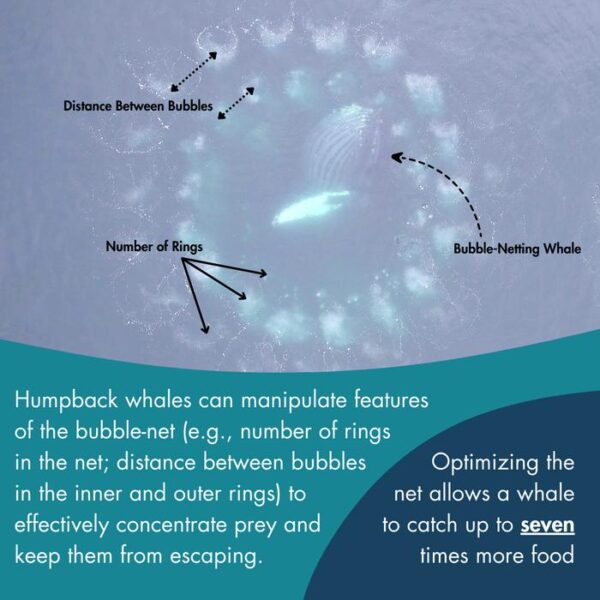Humpback whales have joined the elite club of animals known to make and use tools. A new study reveals these marine giants craft intricate “bubble-nets” to catch their prey, showing a level of skill previously unrecognized in cetaceans.
Researchers from the University of Hawaii and Alaska Whale Foundation observed humpbacks in Southeast Alaska creating complex bubble patterns to trap krill, their primary food source. These bubble-nets aren’t just simple circles – the whales carefully control the number of rings, size, depth, and spacing between bubbles to maximize their catch.
Dr. Lars Bejder, Director of the Marine Mammal Research Program at the University of Hawaii, explains the significance: “We discovered that solitary humpback whales in southeast Alaska craft complex bubble nets to catch krill, which are tiny shrimp-like creatures. These whales skillfully blow bubbles in patterns that form nets with internal rings, actively controlling details like the number of rings, the size and depth of the net, and the spacing between bubbles.”
This advanced technique allows the whales to capture up to seven times more prey in a single dive without expending extra energy. Such efficiency is crucial for these migratory animals, who must build up enough fat reserves during their Alaskan summer to sustain their long journey to Hawaiian breeding grounds.
High-Tech Tools Reveal Underwater Secrets
Studying marine mammals presents unique challenges, but advances in technology are opening new windows into their behavior. The research team used a combination of non-invasive suction-cup tags and aerial drones to gather data on the whales’ movements both above and below the water’s surface.
Dr. William Gough, a researcher involved in the study, highlights the difficulties: “Whales are a difficult group to study, requiring skill and precision to successfully tag and/or drone them.” The remote Alaskan location added another layer of complexity, emphasizing the importance of collaboration with local experts at the Alaska Whale Foundation.
Why It Matters
Understanding how humpback whales hunt is crucial for their conservation. With a quarter of all cetacean species at risk of extinction, insights into their feeding behavior can help resource managers better protect critical habitats. This research also expands our understanding of animal intelligence and tool use, placing humpbacks in a select group of species known to manufacture their own hunting implements.
Dr. Andy Szabo, Executive Director of the Alaska Whale Foundation, sees hope in these findings: “What I find exciting is that humpbacks have come up with complex tools allowing them to exploit prey aggregations that otherwise would be unavailable to them. It is this behavioral flexibility and ingenuity that I hope will serve these whales well as our oceans continue to change.”
The study, published in Royal Society Open Science, opens up new avenues for research into cetacean behavior and adaptability. As ocean environments face increasing threats from climate change and human activity, the humpbacks’ demonstrated ingenuity may prove crucial to their survival.
Future research will delve deeper into the physics and energetics of bubble-netting, as well as explore other feeding strategies employed by these remarkable marine mammals. As we continue to unlock the secrets of humpback whale behavior, we gain not only scientific knowledge but also a greater appreciation for the complexity and resilience of life in our oceans.
If our reporting has informed or inspired you, please consider making a donation. Every contribution, no matter the size, empowers us to continue delivering accurate, engaging, and trustworthy science and medical news. Independent journalism requires time, effort, and resources—your support ensures we can keep uncovering the stories that matter most to you.
Join us in making knowledge accessible and impactful. Thank you for standing with us!

